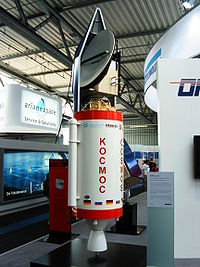
Photo from wikipedia
Thanks to the medium-to-high resolution and wide coverage imaging ability, satellite synthetic aperture radar (SAR) systems are momentously developed for intelligent maritime surveillance, especially for ship classification in SAR images.… Click to show full abstract
Thanks to the medium-to-high resolution and wide coverage imaging ability, satellite synthetic aperture radar (SAR) systems are momentously developed for intelligent maritime surveillance, especially for ship classification in SAR images. Previous researchers mostly utilized the geometric, radiometric, and structural features combined with the traditional machine-learning (ML) methods to conduct ship classification in high-resolution (HR) SAR images. However, the handcrafted features showed weak representation for the medium-resolution (MR) SAR images, and the normal ML methods are less powerful to deal with the intraclass diversity and interclass similarity in the MR SAR ship images. To address these issues, this article extends the dense convolutional networks to the MR SAR ship classification for better deep features extraction and proposes a multitask learning framework within which the softmax log-loss and the triplet loss are jointly minimized for more effective ship classification in MR SAR images. The triplet loss is computed by imposing a similarity constraint on the deep embeddings via the deep metric learning (DML) scheme such that the deep representations of the same class are pulled much closer to each other and those from different classes are pushed as farther apart as possible. However, the triplet loss in the usual DML utilizes the triplets mined in a training batch independently, which ignores the contextual information. So, we propose to impose a Fisher discrimination regularization term on the deep embeddings to explore the global information of learned embeddings, and hence the designed task-specific networks will be trained to have more robust and better recognition performance. Extensive experiments on the MR SAR ship data set collected from the Sentinel-1 SAR images demonstrate that the proposed method can achieve superior performance for the 3- and 5-class recognition tasks with regard to the comparing CNN models.
Journal Title: IEEE Transactions on Geoscience and Remote Sensing
Year Published: 2021
Link to full text (if available)
Share on Social Media: Sign Up to like & get
recommendations!